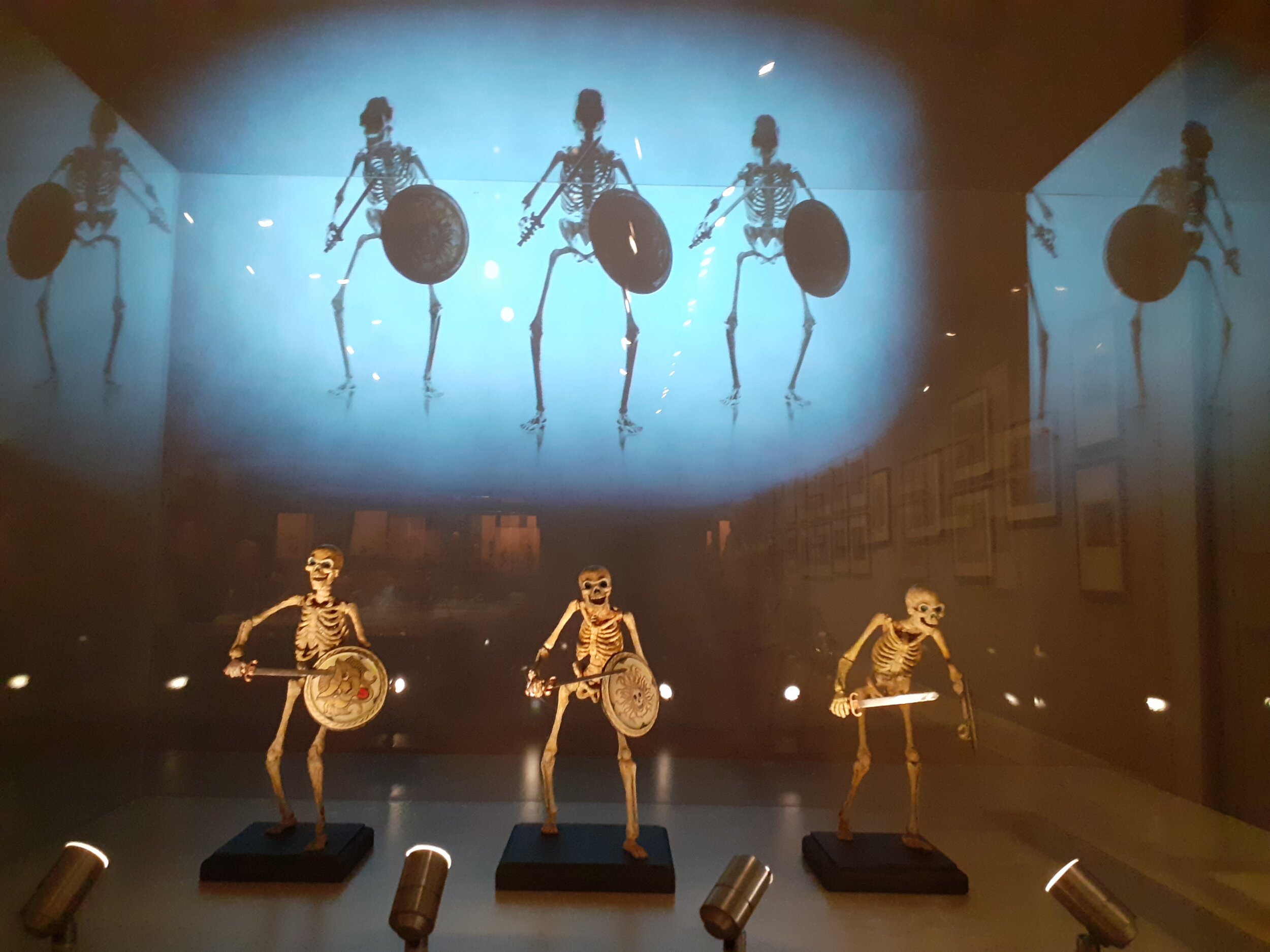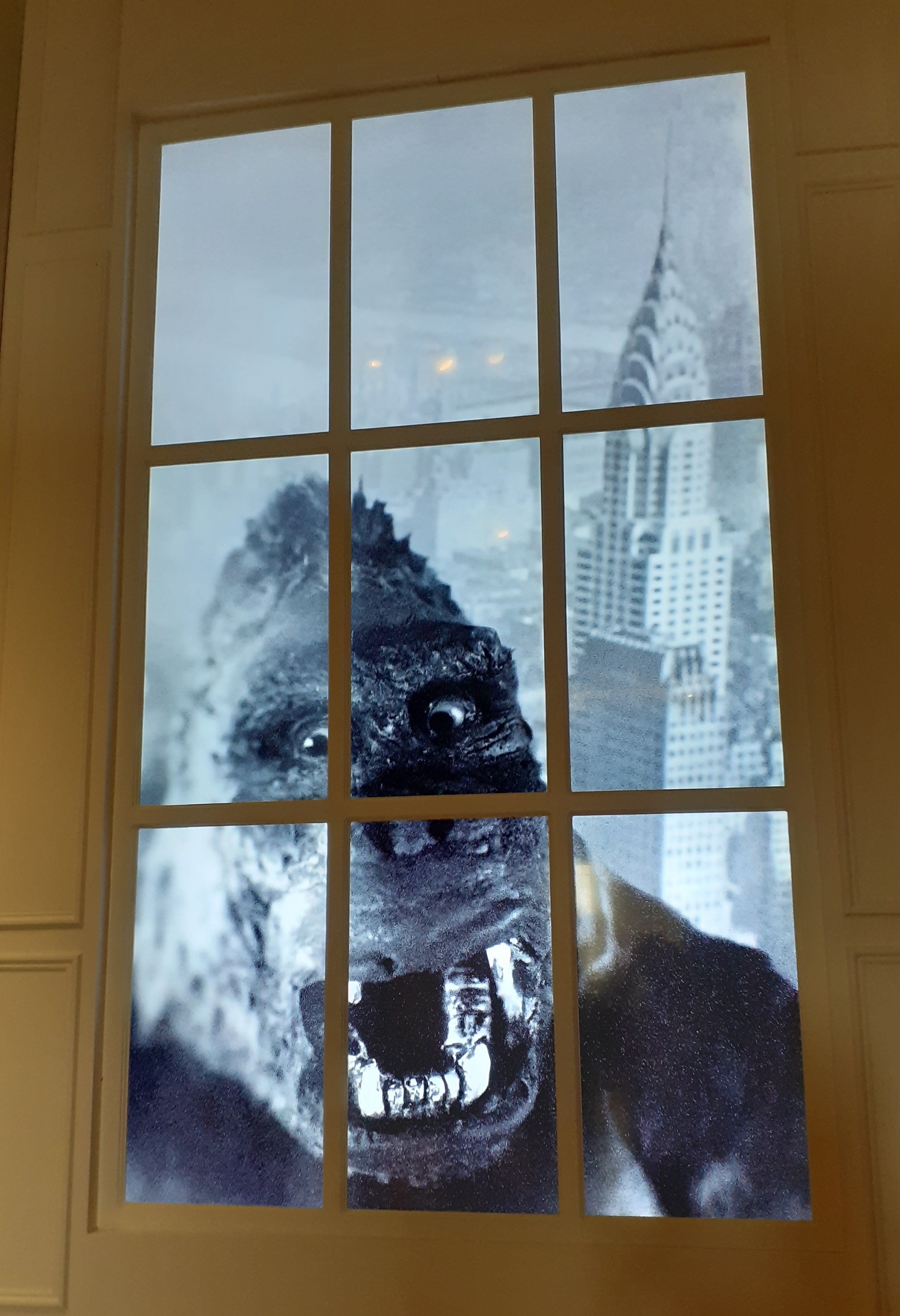Exhibition Review: Ray Harryhausen - Titan of Cinema
Skeleton models from Jason and the Argonauts, part of Ray Harryhausen - Titan of Cinema exhibition (image author’s own)
“It’s important that you believe in the fantasies you are creating on the screen. Otherwise, you end up with a tongue in cheek attitude – which, for me, is death to a fantasy picture.”
Ray Harryhausen, Film Comment, 1977 [1]
A friend and I were recently reminiscing about a series of films screened on TV at some point during the 1970s. They were on at around 4.30pm on Thursday afternoons - the perfect time to have raced home from school, dump your bag and then collapse on the leatherette sofa with some crisps.
The films were mainly science-fiction and fantasy fayre, such as Jack the Giant Killer (1962) or anything starring Doug McClure, sans sleeves. However, easily the most memorable and which continued to entertain us, and our own children, for many years were those created by Ray Harryhausen.
With such classic and beloved films as Jason and the Argonauts (1963) and Clash of the Titans (1981), as well as his early work with Mighty Joe Young (1949) and Earth vs the Flying Saucers (1956), Ray Harryhausen was a special effects innovator, using stop-frame animation to create memorable creatures [2] and scenes that have not only influenced countless film-makers, but have become embedded in our psyche from those childhood screenings.
Presented in partnership with the Ray and Diana Harryhausen Foundation, Ray Harryhausen: Titan of Cinema is a major exhibition celebrating one of the true pioneers of cinema. Taking place across several spaces and floors of the Scottish National Gallery of Modern Art (Modern Two) in Edinburgh, the exhibition offers a retrospective of Harryhausen’s life and career, encompassing his own influences, actual models, sketches, artwork, and artefacts.
Titan of Cinema confirms Harryhausen’s cultural and artistic significance. As Danny Peary states, the skeleton fighting scene from Jason and the Argonauts is “perhaps the best special effects sequence of all time.” [3] No wonder these iconic skeletons form the key marketing image for the exhibition.
Ray Harryhausen is not only important for his technical skill, but for the fact that his models, manipulated with small movements, as part of the stop-motion process, become living, breathing creatures. They are truly actors within each scene.
Look at the confused and disorientated alien creature Ymir escaping from its restraints in 20 Million Miles to Earth (1957) or the slow, menacing turn of the head of Talos in Jason and the Argonauts. As Harryhausen said:
“You’re working with just a pile of old ball-and-socket joints covered with rubber, and you have to inject that with personality.” [4]
Storyboard images from 20 Million Miles to Earth (1957), part of Ray Harryhausen - Titan of Cinema exhibition (image author’s own)
Whilst looking forward to the exhibition, there was some trepidation in regard to how this canon of work was to be presented. There is no doubting the importance of Harryhausen’s actual creations, but they reside in films of poor cultural stereotypes and representation. For a commercial blockbuster exhibition, would these issues be addressed?
At the age of 13, Harryhausen was inspired to learn more about special effects having seen King Kong, when it was released in 1933. He was later mentored by and worked with Willis O’Brien, who created the special effects for the film.
Image of King Kong, part of Ray Harryhausen - Titan of Cinema exhibition (image author’s own)
The beginning of the exhibition highlights the importance of King Kong for influencing a young Harryhausen in stop-motion animation, but also points out the controversies of the film, with its racist stereotypes and demonisation of blackness. A view clearly outlined by David Rosen in his 1975 essay, King Kong: Race, Sex & Rebellion:
“The image of King Kong on a Broadway stage may correspond very closely to white America’s attitudes toward the black men in the 1930s: an object of entertainment, but also of fear. The ape is apparently securely chained, but with the ever-present potential for bursting his chains and wreaking violence and destruction with all the power of his supposed “savage” primitive nature.” [5]
Harryhausen’s animation career began with Puppetoons for Paramount Pictures in 1940. The exhibition unflinchingly informs us of some of the crude stereotypes portrayed in these shorts, with discussion of the deep racial segregation present at that time in the USA. Further reading about the history of black stereotyping, with particular reference to blackface, can be found in this earlier blog post.
Poor representation is found in Harryhausen’s later films when the middle Eastern adventurer Sinbad is played by white Western actors Kirwan Matthews, John Philip Law and Patrick (son of John) Wayne. There is also the regressive stereotyping of women, often playing ‘damsels in distress’ or wicked sorceresses.
The exhibition does not try to hide from all this and provides important contextual information from which to view the work. There is perhaps another exhibition within here based around Hollywood appropriation.
As the Harryhausen story continues, we see more of his original models and work, including the Pegasus and Medusa from Clash of the Titans, detailed drawings for his planned re-make of The War of the Worlds, explanations of the stop-motion process and of course those battling skeletons. All beautifully lit and presented. The Scotsman’s review of the exhibition describes this experience perfectly:
“The intriguing thing is that, despite showing us exactly how the magic is made, it doesn’t become any less magical. If anything, it is more marvellous. This is magic in which the audience was complicit. Unlike today’s all-powerful digital effects and CGI, people were required to bring their imaginations, and they did. And then they enjoyed being scared by what they had imagined.”[6]
Timed entrances provide us with space to enjoy the work and even though we have to move through corridors and up stairways, walls are adorned with tentacles [7] and the giant limbs of Talos to playfully retain us in Harryhausen’s imagination.
With accompanying soundtrack music, including Bernard Herrmann’s celebrated score for Jason and the Argonauts, along with the clear, aforementioned interpretation, this is a very well-presented, almost immersive experience into Harryhausen’s films.
And they are very much Harryhausen’s films. John Landis described him as “the only technician who is an auteur” [8] Auteur theory, as outlined by the critics in Cahiers du Cinema supported the idea of “a cinema of a personal vision, displaying through a distinctive style the presence of an auteur” [9] This is mainly perceived as the vision of the director. Hitchcock and Truffaut were often viewed as the key visionaries for proponents of this theory.
Whilst the exhibition does include a brief film, in which actors such as Caroline Munro describe their experience of working with Harryhausen, overall very little is revealed about other creatives working on these films. For example, Sinbad and the Eye of the Tiger (1977) was helmed by prominent actor and director Sam Wanamaker, but the film remains resolutely Harryhausen’s. It wasn’t until Clash of the Titans in 1981, where he began to work with a small team, but he often worked alone with his models. A singular artist creating his vision.
Harryhausen was the selling point of these films. Nobody talks about Jason and the Argonauts as a Don Chaffey film. I believe those who worked on these movies would agree with this, but the debate re authorship and collaboration in relation to the cinema language of these films could have been explored further.
The exhibition is timed to coincide with the 100th anniversary of Harryhausen’s birth in 1920. However, whilst celebrating his artistic achievements in the past, it also wants to support his legacy. Renowned film-makers such as Steven Spielberg and Tim Burton have professed the debt they owe to Harryhausen, but the exhibition also highlights new and upcoming talent in animation who are moving the genre forward. These include Ru Kuwahata, Neeraja Raj and Suzie Templeton.
Today, cinema is dominated by CGI special effects. It was this approaching advance in digital technology that led Harryhausen to retire from film-making after Clash of the Titans.
CGI has produced some stunning films and yet there can be a distance and coldness to them, when compared to the practical, literal hands-on approach of Harryhausen.
When watching the trailer for the forthcoming film Venom 2, one almost feels assaulted by the maelstrom of destruction and special effects on show. The Titan of Cinema exhibition presents a world of intimate and nuanced technique and craft, where it would take over four months to create four minutes of action, as in the case of those skeletons from Jason and Argonauts. Nearly sixty years later that scene still scares and delights.
In 1992 Harryhausen received an Academy Award (on display in the exhibition) for his outstanding technical contribution to cinema. Presenting the Oscar, Tom Hanks said:
“Some people say Casablanca or Citizen Kane. I say Jason and the Argonauts is the greatest film ever made.”
Ray Harryhausen – Titan of Cinema is at Scottish National Gallery of Modern Art (Modern Two), Edinburgh until 20 February 2022.
An online exhibition experience is also available here.
[1] Stein, E. and Harryhausen, R. (1977) The Thirteen Voyages of Ray Harryhausen. Film Comment, 13 (6), 24-28
[2] “I don’t like the term “monster” because that’s not what we do. All our creatures are misunderstood creatures, because they usually come from another world.” Ray Harryhausen.
Landis, J. (2011) Monsters in the Movies. London: Dorling Kindersley Ltd
[3] Peary, D. (1982) Cult Movies. London: Vermilion & Company
[4] Stein, E. and Harryhausen, R. (1977) The Thirteen Voyages of Ray Harryhausen. Film Comment, 13 (6), 24-28
[5] Rosen, D.N. (1975) King Kong: Race, Sex & Rebellion. Jump Cut: A Review of Contemporary Media, 6, 7-10
[6] Mansfield, S. (2020) Art Review: Ray Harryhausen – Titan of Cinema. The Scotsman, 2 November.
[7] These belong to the giant octopus from It Came From Beneath the Sea (1955), renamed a sextopus due to the fact that it only had six tentacles due to budget restrictions.
[8] Brooke, M. (2012) Ray Harryhausen Special Effects Titan [Review] Sight and Sound, 22 (12), 101-102
[9] Cook, P. (1985) For a New French Cinema: The Politique Des Auteurs. In: Cook, P. The Cinema Book, Third Edition. London: British Film Institute.


